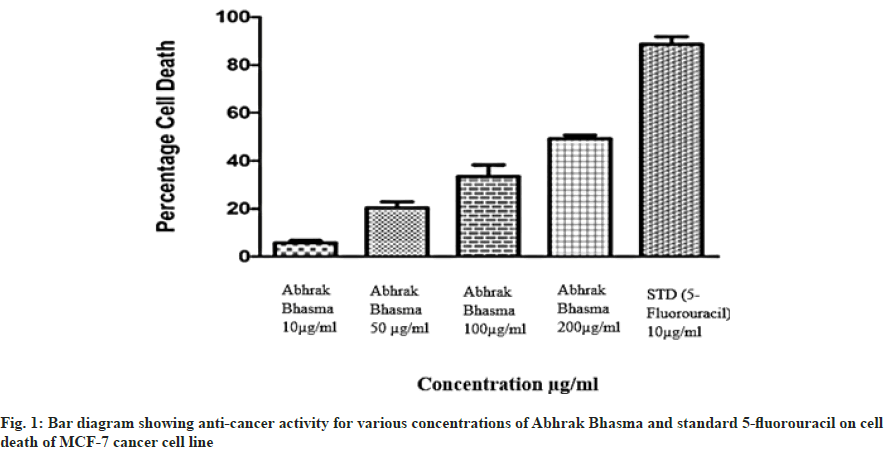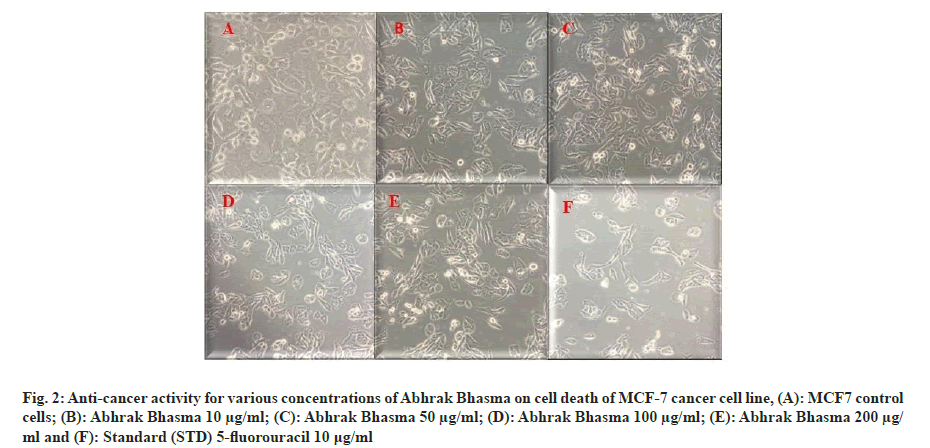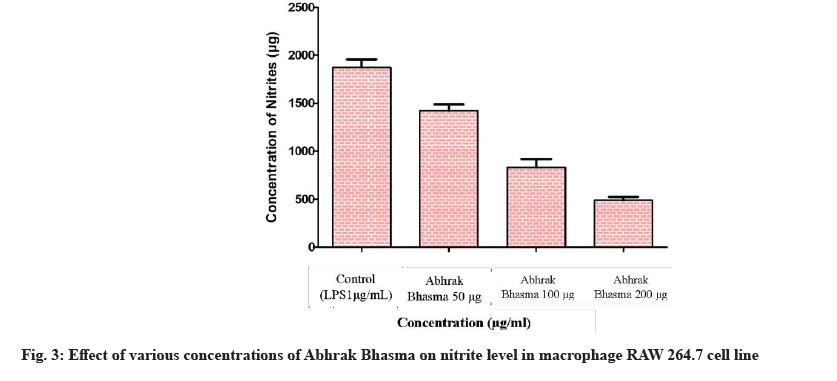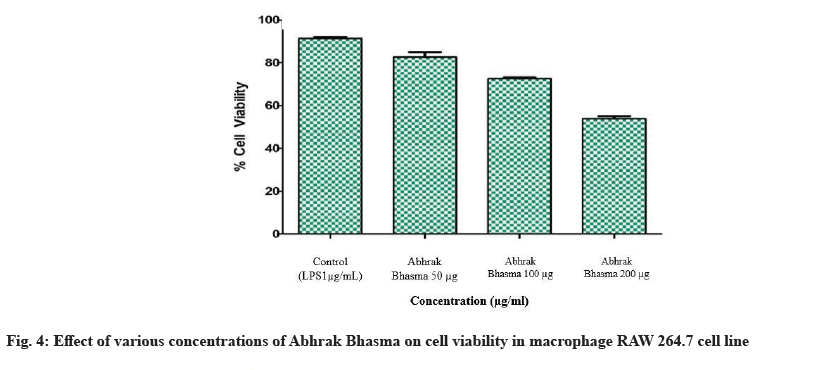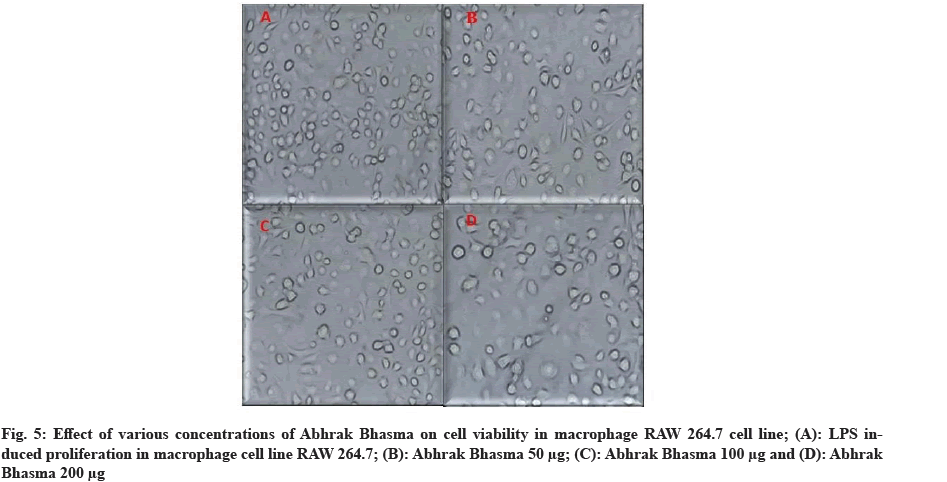- *Corresponding Author:
- Geetha Nandagopalan
Department of Zoology, PSG College of Arts and Science, Coimbatore, Tamil Nadu 641014, India
E-mail: geethsen@gmail.com
| Date of Received | 13 June 2023 |
| Date of Revision | 09 August 2024 |
| Date of Acceptance | 01 October 2024 |
| Indian J Pharm Sci 2024;86(5):1621-1627 |
This is an open access article distributed under the terms of the Creative Commons Attribution-NonCommercial-ShareAlike 3.0 License, which allows others to remix, tweak, and build upon the work non-commercially, as long as the author is credited and the new creations are licensed under the identical terms
Abstract
Abhrak Bhasma (Shatputi) is a time tested classical Ayurvedic formulation, prepared from mica, as well as the juices of numerous other indigenous substances. In this work, we focus on the efficacy of Abharak Bhasma on anticancer activity and immunomodulatory effects using breast cancer Michigan Cancer Foundation-7 cell line and macrophage cell line Robert Abelson leukemia virus 264.7. The in vitro anti-cancer activities of the formulation were evaluated using 3-(4,5-dimethylthiazol-2-yl)-2,5- diphenyltetrazolium bromide assay. The percentage of cell death against Michigan Cancer Foundation-7 cell breast cancer cells increases with an increase in the concentration of Abhrak Bhasma. A high percentage of cell death (49.22±1.504 %) was observed at the concentration of 200 µg/ml of Abhrak Bhasma. The corresponding half-maximal inhibitory concentration value of Abhrak Bhasma was found to be 193.2±10.72 µg/ml. There was a dose-dependent decrease in the nitrite level in Robert Abelson leukemia virus 264.7 incubated with Abhrak Bhasma at the concentration ranges from 50 to 200 µg/ml. A significant reduction in nitrite level was found to be about 489.3±35.92 at 200 µg/ml. Lipopolysaccharide (1 µg/ml) treated was served as a control with a maximum nitrite level of about 1873±83.59 µg. The present study reveals that the percentage of cell viability in the macrophage cell line decreases with an increase in the concentration of Abhrak Bhasma. The least viability of the cell was observed at the concentration of 200 µg/ml showing 53.85±1.211 %. Our study highlights dual qualities of Abhrak Bhasma as a potential drug against breast cancer and as an immunomodulatory drug showing anti-inflammatory properties.
Keywords
Breast cancer, Abhrak Bhasma, cell viability, nitrite level, anti-inflammatory, MCF-7 breast cancer cell line, RAW 264.7 macrophage cell line
A common illness with widespread documentation is cancer. The predicted number of new instances of female breast cancer in 2020 is 2.26 million, making breast cancer as the most frequently diagnosed cancer globally[1]. Indian traditional remedies have a long history of successfully treating a variety of illnesses. It provides support for a sizable, rapidly expanding industry with yearly sales of 1 billion USD[2]. Most commercially available chemotherapeutics have major side effects, which put people's lives at stake[3,4]. To address this issue, innovative strategies with excellent biocompatibility and minimal cancer chemotherapy side effects are Bhasma is a class of herbometallic ayurvedic remedies that include the puta (repeating cycles) technique of incineration and the repeated burning of various metals or their ores combined with decoction of various herbal items. These preparations are sometimes referred to as nanomedicines since the components of the finished product typically have sizes in the nanometer range[6,7]. In comparison to plant-based medications, bhasmas offer various advantages, including stability over longer time periods, lower doses, simple storage, quick accessibility and availability[8-10]. Several Bhasmas have been discovered to have various therapeutic benefits; Heerak Bhasma (nanodiamonds-based ayurvedic herbomineral preparations) possess immunostimulatory and tumor-killing qualities[11]. Manikya Bhasma functions as a nanomedicine and the cell death it causes inside cancer cells is characterized by mitochondrial-dependent apoptosis[12]. Anti-cancer[13-15], anti-inflammatory[16], analgesics[17] and immunomodulatory[18] actions were disclosed by Swarna Bhasma. It has been established that Rajatha Bhasma possesses anti-cancer and hepatoprotective effects[19,20].
Abhrak Bhasma is a red powder with particles between 100 and 1000 nm in size that is high in iron, calcium, potassium and other minerals[21-23]. There is proof of anti-diuretic[24], anti- stress, anti-inflammatory, immunomodulatory[25], adaptogenic[26], memory-enhancing[27], anti-cancer[28], anti-diabetic[29] and Deoxyribonucleic Acid (DNA) repair[30] role of Abhrak Bhasma. Even though lung, leukemia and prostate cancer cell lines exhibited anticancer activity, prostate cancer cell line revealed significant positive in vitroanticancer activity for Abhrak Bhasma[28]. Immunomodulation is a very general word that refers to any modifications to the immune system and might include the induction, expression, amplification or inhibition of any component or stage of the immune response[31]. Immunomodulators are biological or synthetic compounds that have the ability to activate, inhibit or modify any immune system function, including the innate and adaptive immune systems[32]. Recent scientific studies have focused on the potential therapeutic use of Ayurveda herbal remedies for modulating immune response. Rasayana includes immunomodulators with a range of chemical compositions and molecular sizes. They work by altering a number of immune system processes, including the activation and multiplication of macrophages, stimulation of phagocytosis, proliferation of lymphocytes producing T helper cells and activation of complement pathways. Immunostimulants have the potential to improve both the nonspecific and specific immune response to infection[33,34]. Anticancer activity on breast cancer cell lines and immunomodulatory effects of Abhrak Bhasma, have not yet been the subject of any studies. Hence in this work we have focused on the efficacy of Abhrak Bhasma on anticancer activity and immunomodulatory effects using Human breast cancer cell line (MCF-7) and Macrophage cell line (RAW 264.7).
Materials and Methods
Abhrak Bhasma-Baidyanath (Nagpur) Abhrak Bhasma (Shatputi) is time tested classical ayurvedic formulation, prepared from mica as well as the juices of numerous other indigenous substances.
Anti-cancer activity study:
10 mg/ml Abhrak Bhasma, MCF-7 breast cancer cell line, Fetal Bovine Serum (FBS), trypsin, EDTA, Haemocytometer, 1 % streptomycin, Pencillin G, Amphotericin B, Glucose, 3-[4,5-dimethyl thiozole-2-yl]-2-5-diphenyl tetrazolium bromide (MTT), Phosphate Buffer Saline pH 7.4, Dimethyl Sulfoxide (DMSO), microplate Enzyme-Linked Immunosorbent Assay (ELISA) reader.
Procedure: 10 mg of Abhrak Bhasma dissolved in 1 ml of distilled water (stock solution), was then further diluted in distilled water to attain the following concentrations of 10, 50, 100, 200 µg/ml Abhrak Bhasma. MCF-7 breast cancer cell line which was obtained from the National Centre for Cell Sciences (NCCS), Pune, cultured in a Minimal Essential Medium (MEM) with 10 % FBS, trypsin, EDTA, Glucose, 1 % streptomycin, Pencillin G and Amphotericin B, in a fully humidified atmosphere with 5 % CO2 at 37°. MCF-7 breast cancer cell line was made to detach from the MEM using trypsin and EDTA to create single cell suspensions. Viable MCF-7 breast cancer cells in single cell suspension were counted using a Haemocytometer. Viable MCF-7 breast cancer cells in single cell suspension diluted to a density of 1×105 cells/ml, using a medium containing 5 % FBS. 100 μl per well of the MCF-7 breast cancer cell suspension seeded were in 96-well plates at plating density of 10 000 cells/well and incubated at 37°, 5 % CO2, 95 % air and 100 % relative humidity to allow for cell attachment. After 24 h of incubation, the cells were treated with 100 μl of different concentrations of the Abhrak Bhasma (10, 50, 100, 150 and 200 µg/ml). Following the treatment with Abhrak Bhasma, the plates were further incubated for 48 h at 37°, 5 % CO2, 95 % air and 100 % relative humidity. The medium without samples served as control and triplicate maintained for all used concentrations.
3-[4,5-dimethyl thiozole-2-yl]-2-5-diphenyl tetrazolium bromide (modified MTT assay):
The effect of Abhrak Bhasma on the viability of MCF-7 breast cancer cell line were determined by modified MTT assay[35]. 100 μl of cell suspensions in growth medium plated in 96-well microtiter plate at concentrations of 1×104 cells/well and incubated for 48 h at 37° in a humidified incubator. After 48 h, 0.1 % DMSO was added to the incubated cells suspension and further incubated for 72 h at 37°. Suspension was washed with pH 7.4 phosphate buffer. 20 μl of MTT (5 mg/ml) added to all wells in the plate and incubation continued for 4 h at 37° which resulted in the formation of Formazan. Solution in all wells was aspirated. 100 μl buffered 0.1 % DMSO added to dissolved Formazan and plates shaken well for 5 min. Optical density measured using a microplate Enzyme-Linked Immunosorbent Assay (ELISA) reader at 540 nm, with 0.1 % DMSO as control. Cytotoxicity of the Abhrak Bhasma was obtained by comparing the absorbance (inferred from ELISA) between the control and samples. The percentage inhibition calculated using the formula:
Percentage cell viability=A540 of treated cells/A540 of control cells×100 IC50 calculated from dose-response curves.
Immunomodulatory study:
Abhrak Bhasma, macrophage cell line RAW 264.7, FBS, sodium nitrite solution, trypsin EDTA, 1 % streptomycin, penicillin-streptomycin (10 %) , 1 µl lipopolysaccharide (LPS) (1 µg/ml), DMSO, Microplate (ELISA) reader, centrifuge, lysis buffer (0.1 M TrisHCl, 0.25 M EDTA, 2 M NaCl, 0.5 % Triton x-100), sulphosalicylic acid, Vortex mixer, Griess reagent, sodium nitrite solution.
Procedure:
Cell culture, measurement of cell viability: Macrophage cell line RAW 264.7 was obtained from National Center for Cell Science (Pune, India). Cell line was cultured in Dulbecco's modified eagle medium supplemented with FBS (10 %) containing penicillin-streptomycin (10 %) at 37° in a humidified atmosphere containing 5 % CO2. Cells were plated at a density of 1×104 cells/well in 25 or 75 cm2 flasks, or in 96-well plate overnight. RAW 264.7 were grown to 60 % confluence followed by activation with 1 µl LPS (1 µg/ml). LPS stimulated RAW cells were exposed with different concentration (50, 100, 200 µg/ml) of Abhrak Bhasma and incubated for 24 h. After 24 h of incubation, the cells were digested and centrifugation was done at 6000 rpm for 10 min. Supernatant was discarded and cells were then re-suspended in 200 µl of cell lysis buffer (0.1 M TrisHCl, 0.25 M EDTA, 2 M NaCl, 0.5 % Triton x-100). The samples were then kept at 4° for 20 min. After incubation, the immunomodulatory response was performed by estimating nitrite levels in the cell lysate.
Estimation of cellular nitrite level:
The level of nitrite was estimated by the method of Lepoivre et al.[36]. To 0.5 ml of cell lysate, 0.1 ml of sulphosalicylic acid was added and vortexed well for 30 min. The samples were then centrifuged at 5000 rpm for 15 min. The protein-free supernatant was used for the estimation of Nitrite levels. To 200 μl of the supernatant, 30 μl of 10 % NaOH was added, followed by 300 μl of Tris-HCl Buffer and mixed well. To this, 530 μl of Griess reagent was added and incubated in the dark for 10-15 min and the absorbance was read at 540 nm against a Griess reagent blank. Sodium nitrite solution was used as the standard. The amount of nitrite present in the samples was estimated from the standard curves obtained. The bar graph represents values with standard error.
Results and Discussion
In vitro anti-cancer evaluation of Abhrak Bhasma on the cell death against MCF-7 breast cancer cell line was performed at varying concentration ranging from 10 to 200 µg/ml. The result obtained from the study reveals that the percentage of cell death of MCF-7 breast cancer cell line increases with increase in concentration of Abhrak Bhasma. High percentage of cell death was observed at the concentration of 200 µg/ml as 49.22±1.504 %. Followed by this at 100 µg and 50 µg shows 33.45±4.865, 20.31±2.559, similarly at 10 µg/ml it shows 5.718±0.9802 % cell death in MTT assay (fig. 1). The corresponding IC50 value of Abhrak Bhasma was found to be 193.2±10.72 µg/ml. The morphology of cells treated with Abhrak Bhasma in the present study showed significant cell shrinkage/rounding and formation of apoptotic cell bodies due to cellular plasma membrane deformation, apoptotic cell death and cytoplasm shrinkage (fig. 2). Furthermore, Jha et al.[12] reported that Manikya Bhasma showed significant reduction in the number of cells in the S-phase (proliferation phase with active DNA synthesis). It was observed that the cytotoxicity of the Bhasma has made the cancer cells unable to recover from the cellular damages and could not revert back to their original phase, similar mechanisms might have caused the above said cellular damages in the present study. The present study suggests that Abhrak Bhasma has an immunomodulatory effect on RAW 264.7 cells, as evidenced by the observed dose-dependent decrease in nitrite levels and macrophage cell viability. LPS (1 µg/ml) treated well was served as a control with maximum nitrite level of about 1873±83.59 µg. The formulation Abhrak Bhasma at the dose of 50 µg/ml shown a decrease in nitrite level of about 1422±66.3 µg, similarly at the concentration of 100 µg/ml it was 831.3±85.76 µg. At higher concentrations of Abhrak Bhasma, there was a significant decrease in nitrite levels, with the maximum decrease 489.3±35.92 µg observed at 200 µg/ml (fig. 3). These results suggest that Abhrak Bhasma may be able to modulate the production of nitric oxide, a key signaling molecule involved in the immune response. Nitric oxide generated by inducible NOS is vital in inflammation and immune system control[37]. The reduction in nitrite level by Abhrak Bhasma suggest the anti-inflammatory properties as reported in Quercus infectoria by Wan-Nor-Amilah et al.[38]. The result obtained from the study reveals that the percentage of cell viability of macrophage cell line decreases with increase in concentration of Abhrak Bhasma. The least viability of cell was observed at the concentration of 200 µg/ml shows 53.85±1.211 % (fig. 4 and fig. 5). The present study indicates that the Abhrak Bhasma displays promising potential in vitro anti-cancer activity on breast cancer cell line MCF-7 and immunomodulatory effects in Macrophage cell line RAW 264.7. This suggests that, in addition to its effectiveness against prostate cancer, it may also be useful in the treatment of breast cancer. However, further in vivo studies are needed to gain a better understanding of the potential effects of Abhrak Bhasma.
Fig 2: Anti-cancer activity for various concentrations of Abhrak Bhasma on cell death of MCF-7 cancer cell line, (A): MCF7 control cells; (B): Abhrak Bhasma 10 μg/ml; (C): Abhrak Bhasma 50 μg/ml; (D): Abhrak Bhasma 100 μg/ml; (E): Abhrak Bhasma 200 μg/ ml and (F): Standard (STD) 5-fluorouracil 10 μg/ml
Conflict of interest:
The authors declared there is no conflict of interest.
References
- Ferlay J, Colombet M, Soerjomataram I, Parkin DM, Piñeros M, Znaor A, et al. Cancer statistics for the year 2020: An overview. Int J Cancer 2021;149(4):778-89.
[Crossref] [Google Scholar] [PubMed]
- Dwivedi V, Anandan EM, Mony RS, Muraleedharan TS, Valiathan MS, Mutsuddi M, et al. In vivo effects of traditional Ayurvedic formulations in Drosophila melanogaster model relate with therapeutic applications. PloS One 2012;7(5):e37113.
[Crossref] [Google Scholar] [PubMed]
- Alessio E, Guo Z. Metal anticancer complexes–activity, mechanism of action, future perspectives. Eur J Inorg Chem 2017;2017(12):1539-40.
- Nurgali K, Jagoe RT, Abalo R. Adverse effects of cancer chemotherapy: Anything new to improve tolerance and reduce sequelae? Front Pharmacol 2018;9:245.
[Crossref] [Google Scholar] [PubMed]
- Ruidas B, Sur TK, Pal K, Som Chaudhury S, Prasad P, Sinha K, et al. Herbometallic nano-drug inducing metastatic growth inhibition in breast cancer through intracellular energy depletion. Mol Biol Rep 2020;47:3745-63.
[Crossref] [Google Scholar] [PubMed]
- Kumar Pal S. The Ayurvedic bhasma: The ancient science of nanomedicine. Recent patents on Nanomedicine 2015;5(1):12-8.
- Bengal S, Ramteke V, Belge R, Mane N, Firdaus S. Role of Abhrak bhasma as rasayan aushadi with special reference to anti-ageing properties. World J Pharm Res 2020;9(7):7.
- Kumar A, Nair AG, Reddy AV, Garg AN. Availability of essential elements in bhasmas: Analysis of Ayurvedic metallic preparations by INAA. J Radioanal Nuclear Chem 2006;270(1):173-80.
- Singh SK, Gautam DN, Kumar M, Rai SB. Synthesis, characterization and histopathological study of a lead-based Indian traditional drug: Naga bhasma. Indian J Pharm Sci 2010;72(1):24.
[Crossref] [Google Scholar] [PubMed]
- Wijenayake A, Pitawala A, Bandara R, Abayasekara C. The role of herbometallic preparations in traditional medicine–a review on mica drug processing and pharmaceutical applications. J Ethnopharmacol 2014;155(2):1001-10.
[Crossref] [Google Scholar] [PubMed]
- Paladhi A, Rej A, Sarkar D, Singh R, Bhattacharyya S, Sarkar PK, et al. Nanoscale diamond-based formulation as an immunomodulator and potential therapeutic for lymphoma. Front Pharmacol 2022;13:852065.
[Crossref] [Google Scholar] [PubMed]
- Jha S, Trivedi V. Manikya Bhasma is a nanomedicine to affect cancer cell viability through induction of apoptosis. J Ayurveda Integr Med 2021;12(2):302-11.
[Crossref] [Google Scholar] [PubMed]
- Das S, Das MC, Paul R. Swarna Bhasma in cancer: A prospective clinical study. Ayu 2012;33(3):365-7.
[Crossref] [Google Scholar] [PubMed]
- Khoobchandani M, Katti KK, Karikachery AR, Thipe VC, Srisrimal D, Dhurvas Mohandoss DK, et al. New approaches in breast cancer therapy through green nanotechnology and nano-ayurvedic medicine–pre-clinical and pilot human clinical investigations. Int J Nanomed 2020;15:181-97.
[Crossref] [Google Scholar] [PubMed]
- Sharma S, Chorasia SK, Yadav AK. The role of Swarna Bhasma in the treatment of Autoimmune disease. J Ayurveda Integr Med Sci 2021;6(4):285-90.
- Soni H, Sharma S, Malik JK. Synergistic prophylaxis on COVID-19 by nature golden heart (Piper betle) & Swarna Bhasma. Asian J Res Dermatol Sci 2020;3(2):21-7.
- Sarkar PK, Wele A. Presence and activities of carbonaceous nano-materials in Ayurvedic nano-medicine preparations. Int Nano Lett 2023;13(1):41-51.
- Koushik P, Dayma J. Swarna Bhasma as a nanomedicine in Ayurveda: A comprehensive review on its efficacy in remediation of rheumatoid arthritis. J Nanosci Nanoeng Appl 2023;13(3):16-28p.
- Rai AP. Evaluation of antidiabetic activity of Rajata bhasma. Int J Green Pharm 2019;13(4):1-5.
- Rai AP, Tripathi S, Tiwari OP. Assessment of hepatoprotective activity of Rajata Bhasma in CCl4 induced hepatotoxicity rats. Biomed Pharmacol J 2019;12(4):1731-5.
- Kale B, Rajurkar N. Synthesis and characterization of Vanga bhasma. J Ayurveda Integr Med 2019;10(2):111-8.
[Crossref] [Google Scholar] [PubMed]
- Kantak S, Rajurkar N, Adhyapak P. Synthesis and characterization of Abhraka (mica) bhasma by two different methods. J Ayurveda Integr Med 2020;11(3):236-42.
[Crossref] [Google Scholar] [PubMed]
- Varma AS, Bhat S, Nayak D. Analytical evaluation of Abhraka Bhasma samples after marana, amritikarana and lohitikarana. Int J Ayurveda Pharm Res 2024;12(1):46-55.
- Kumar RC, Ilango K, Kumar RM, Vasanth K, Kumar RV, Mitti JG. Evaluation of physico chemical properties and diuretic activity of biotite calx (Abhraka Bhasma) processed with Tribulus terrestris L.: An experimental study. Int J Res in Ayurveda Pharm 2015;6;303-09.
- Balkrishna A, Solleti SK, Singh H, Singh R, Sharma N, Varshney A. Biotite-Calx based traditional Indian medicine sahastraputi-abhrak-bhasma prophylactically mitigates allergic airway inflammation in a mouse model of asthma by amending cytokine responses. J Inflamm Res 2021;14:4743-60.
[Crossref] [Google Scholar] [PubMed]
- Graver SK, Divekar HM, Kumar R, Pahwa ML, Bhardwaj SK, Gupta AK, et al. Experimental evaluation of a composite Indian herbal preparation II (CIHPII) as an adaptogen and its mechanism of action. Int J Pharmacogn 1995;33(2):148-54.
- Parle M, Vasudevan M. Memory enhancing activity of Abana®: An Indian ayurvedic poly-herbal formulation. J Health Sci 2007;53(1):43-52.
- Tamhankar YL, Gharote AP. Effect of Puta on in vitro anticancer activity of Shataputi Abhrak Bhasma on lung, leukemia and prostate cancer cell lines. J Ayurveda Integr Med 2020;11(2):118-23.
[Crossref] [Google Scholar] [PubMed]
- Gopinath H, Shivashankar M. A study on toxicity and anti-hyperglycemic effects of Abhrak Bhasma in rats. J Ayurveda Integr Med 2021;12(3):443-51.
[Crossref] [Google Scholar] [PubMed]
- Kulala DS, Prasad K, Reddy PS, Maruthiyodan S, Joshi MB, Satyamoorthy K, et al. Understanding the effects of Abhraka Bhasma on genotoxicity and its DNA repair potential in mouse model. J Ayurveda Integr Med 2023;14(2):100598.
[Crossref] [Google Scholar] [PubMed]
- Shewalkar VK, Belge R. Role of Panchamruta Rasa (Panchadasha) as a immunomodulator w.s.r. Rasayana: A Review. J Ayurveda Integr Med Sci 2020;5(2):246-62.
- Shantilal S, Vaghela JS, Sisodia SS. Review on immunomodulation and immunomodulatory activity of some medicinal plant. Eur J Biomed 2018;5(8):163-74.
- Chulet R, Pradhan P. A review on rasayana. Pharmacogn Rev 2009;3(6):229-34.
- Singh R, Goel S, Bourgeade P, Aleya L, Tewari D. Ayurveda Rasayana as antivirals and immunomodulators: Potential applications in COVID-19. Environ Sci Pollut Res Int 2021;28(40):55925-51.
[Crossref] [Google Scholar] [PubMed]
- Mosmann T. Rapid colorimetric assay for cellular growth and survival: Application to proliferation and cytotoxicity assays. J Immunol Methods 1983;65(1-2):55-63.
[Crossref] [Google Scholar] [PubMed]
- Lepoivre M, Chenais B, Yapo A, Lemaire G, Thelander L, Tenu JP. Alterations of ribonucleotide reductase activity following induction of the nitrite-generating pathway in adenocarcinoma cells. J Biol Chem 1990;265(24):14143-9.
[Crossref] [Google Scholar] [PubMed]
- Tripathi P, Tripathi P, Kashyap L, Singh V. The role of nitric oxide in inflammatory reactions. FEMS Immunol Med Microbiol 2007;51(3):443-52.
[Crossref] [Google Scholar] [PubMed]
- Wan-Nor-Amilah WA, Syifaa ML, Azlina Y, Shafizol Z, Nurul AA. In vitro immunomodulatory activity of aqueous Quercus infectoria gall extract. Oman Med J 2021;36(3):e265.
[Crossref] [Google Scholar] [PubMed]
